
With all the free resources out there, why would anyone pay for coding? It’s an important question to ask especially with the endless parade of choices to choose from. Finding the perfect computer science platform is not a one-size-fits-all approach.
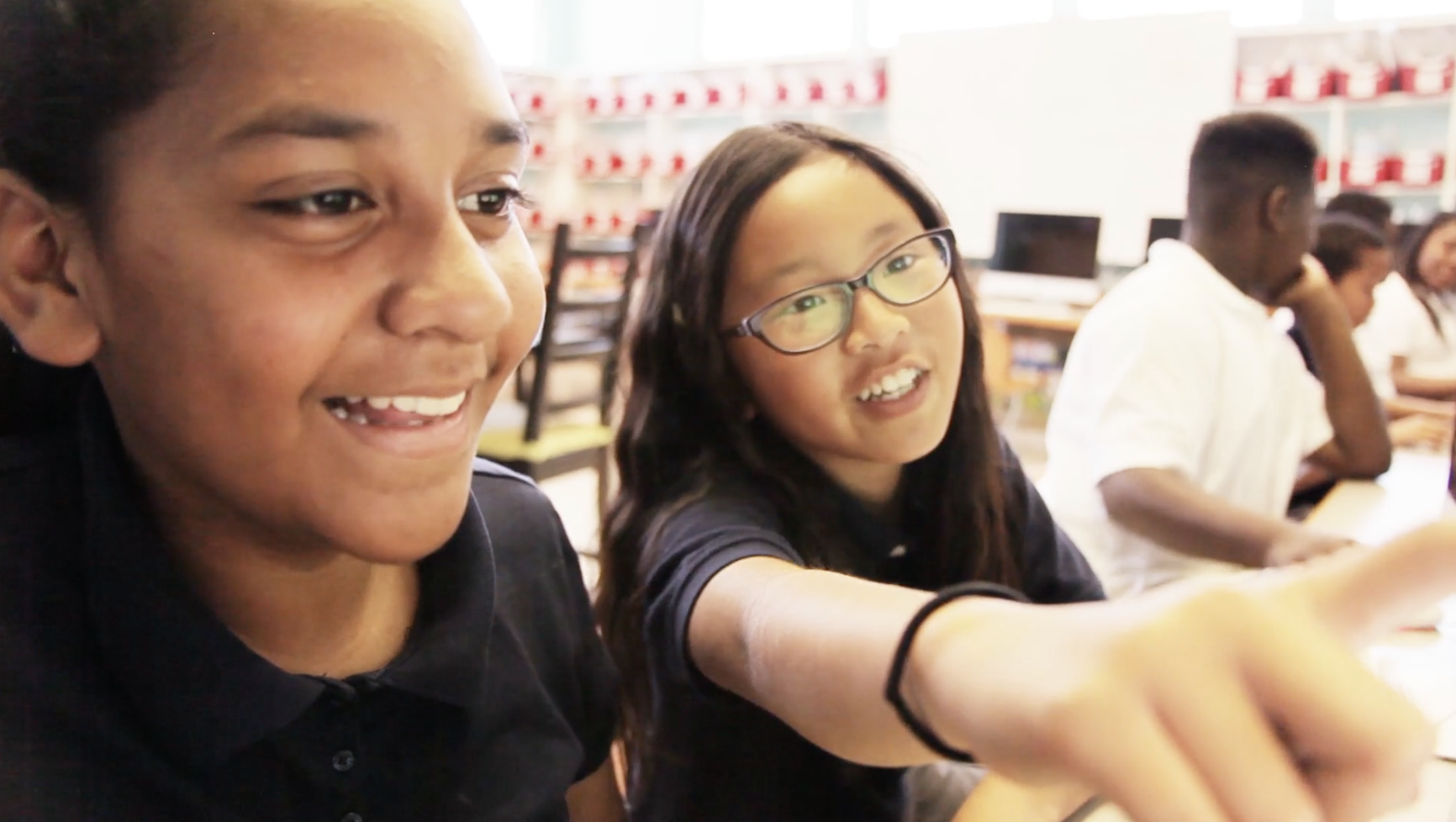
Like working through a line of code, to discover the perfect coding platform it’s important to find the solution that works best for you and your students and moves you from one point to another supporting your objectives along the way.
Of course there are broad reasons why anyone would pay for any membership or subscription based product purchased for self-improvement or learning:
- Pay for it, use it: Some people are more motivated to stick with and actually use something they are paying for - at least initially.
- Extra support: It’s nice to know you may get faster or better support than a regular customer.
- Perks - Everyone loves the little perks you may get from becoming a paid member.
- Access & Convenience - Sometimes the only way to read the next chapter or walk in through the door is to pay for access, even when no perks are offered. Not having to build a gym in your home or drive to a bookstore or library is the trade off for payment.
However, unlike paying for a gym membership or audiobook service there are very specific needs you may have and questions to ask yourself when deciding to pay for a coding platform versus choosing a free resource, especially if you’re a teacher.
Three Questions to Ask Before You Pay for Coding
- Am I ready?
- What are my ultimate objectives?
- How is this coding platform different from all the rest?
Am I ready?
If you’re an educator you may feel a little overwhelmed and not sure if you have the time or resources to venture into something seriously yet. We occasionally talk with teachers who are teaching computer science for the first time or just want to explore ways to introduce it to their current class.
The first step would be understanding the tech resources you have in place at your disposal:
Some questions to ask:
- How many computers or Chromebooks will you be able to use?
- Are the computers updated with a modern browser like Chrome, Safari, Edge, or Firefox?
- Do I only have access to tablets like iPads or Androids?
- What is my school’s regulations on online access?
- Are there any additional school network restrictions?
After you have an idea of tech resources you can use for the platform you chose, you should know how much time you can dedicate to teach coding. A hybrid of instructive, “unplugged” group activities and active coding time is important to establish and reinforce the fundamentals of basic syntax and coding.
Some questions to ask:
- Are you teaching computer science and coding for a full year or a semester?
- Are you teaching during regular class time or after school?
- Are you teaching coding as a full curriculum or supplemental?
- How many students are you teaching and what grade level?
- Are your students younger or more comfortable with introductory drag and drop block-based coding or are they ready to graduate to writing out text based code?
Once you have an idea of the tech resources you can use, the time commitment it will take, and you’re ready to try something that may be new to you; it’s important to ask what you want to accomplish by the end of your class.
What are my ultimate objectives?
You should have an idea of where you want your student’s skills to be by the end of the semester or year. If there is a specific K-12 framework you need to follow you’ll want to make sure any resource you choose will support those concepts. Ultimately, you may have the broader goal of simply introducing coding into your class and giving them a headstart for more advanced lessons they may encounter in advanced programming.
Try to seek out other educators at your school who may have similar goals. Other teachers can make great allies and can help you test out any resources you choose.
Once you know what objectives you need to hit and the tools you have in hand it's time to choose a coding platform.
How is this coding platform different from all rest?
Our best recommendation is to make sure you can test out any platform you’re exploring. Some resources allow you the opportunity to try out their product with most premium features disabled.
CodeCombat gives educators the opportunity to test out our entire Introduction to Computer Science course with everything unlocked (basic equipment and all heroes). You can start as many classes as you want and invite as many students as you want to participate.
If you’re a parent or individual and you don’t want the features of the classroom version, our home version can be accessed at https://codecombat.com/play.
There are many free levels and worlds to try and more created every day by our open source community. You can also subscribe to premium content and unlock exclusive heroes, pets, and content like Web and Game Development.

What does CodeCombat offer me?
The CodeCombat classroom version is a full featured computer science platform which means students will learn to type text based code in Python and JavaScript, how to develop games, and HTML and CSS for web development. Everything you need to teach coding is included in the platform.
Most importantly students are challenged, engaged, motivated to work together, and prepared to learn actual programming.
Problem solving and collaboration
Ruby Bridges Elementary in Alameda, CA is a fairly new school with a brand new computer lab and a district moving toward 1:1 Chromebook implementation within the next few years. Yet just last year, Ruby Bridges had no STEAM program, coding, or a Computer Science teacher at the school. Introducing a computer science and coding plan into a school takes vision and tenacity. Susan Jones-Szabo, Teacher Librarian at Ruby Bridges Elementary, took the challenge in stride.
Ms. Jones-Szabo was helping develop an ‘Innovative Plan’ to present to the school board in order to introduce a possible STEAM program into the school. Ruby Bridges is a Title I school with around 450 diverse students that speak various languages and fit on every level of the economic spectrum. Ms. Jones-Szabo was looking for a program to present to the board that was viable and could demonstrate how technology enhanced other fields and help push the ‘Innovative Plan’ forward at Ruby Bridges.
The question was - how do you find a program that will appeal to a wide range of students and teach practical computer science and programming skills to 4th and 5th graders?
When Ms. Jones-Szabo discovered CodeCombat through Hour of Code she found the perfect solution.
CodeCombat encourages critical thinking through trial and error and collaboration. Students can move at their own pace and their work is saved so they are free to make mistakes and try again until they truly grasp the core underlying concepts.
According to a 2012 report by the National Center for Women and Information Technology, girls are encouraged to participate more when there are opportunities to test concepts, take risks and collaborate in hands-on, active projects with others, which not only bolsters their confidence but demonstrates that confidence does not equal ability. Our own research, shows that girls learn 7% faster in CodeCombat than boys do.
Game-based learning has also shown to reach girls and low-income students better than traditional instruction. In order to create more balance in computer science, CodeCombat also offers diverse character heroes and is translated in over 50 languages for ELL learners.
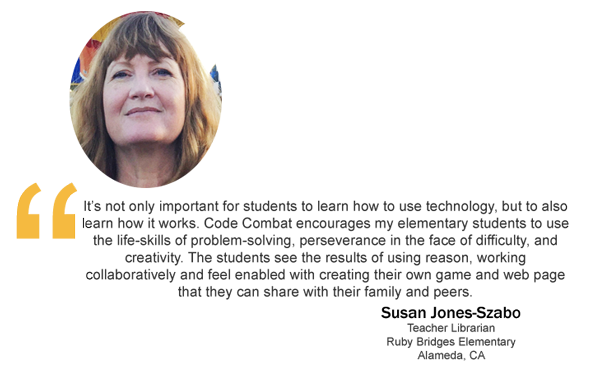
Through Ms. Jones-Szabo efforts and the work of others at Ruby Bridges Elementary the Innovative Plan was approved by the school board and the students of Ruby Bridges are still playing and learning in CodeCombat.
The school board just approved our IP to become a STEAM school! Woo-hoo!!!
— Ruby Bridges STEAM (@RB_STEAM) June 14, 2017
Engagement and motivation
How do you keep a 100 students engaged enough to complete an after-school pilot program?
That was the question, Riverside Unified School District Instructional Services Specialist, Steve Kong had to keep in mind when searching for a variety of computer science resources that were not only engaging but that would teach advanced concepts to students.
Through a partnership with the city, Riverside Unified School District would receive funding for 200 Chromebooks for students. The district would give the Chromebooks to lower-income students who attend an after-school coding club and after they complete the club, they would be able to keep the Chromebooks.
The main goal was to keep students engaged the entire duration of the club using CodeCombat as a way to help pilot the after-school coding club for the first 100 students. Since CodeCombat is essentially a game - students are already encouraged to try it and lessons are presented in a way that motivates them to continue each level. Students are also offered hints if they become stuck. We try to balance the game's difficulty so students don't become frustrated and give up but are challenged enough to stay engaged and reinforce the fundamental concepts.
We’ve eliminated potential distractions by hiding gems, reward points and removing ads. We’ve created final multiplayer arena levels as rewards for students who complete their work, which also allows them a chance to reinforce and practice their skills learned while waiting for other students to catch up so everyone stays in sync.

Riverside Unified School District results from spring:
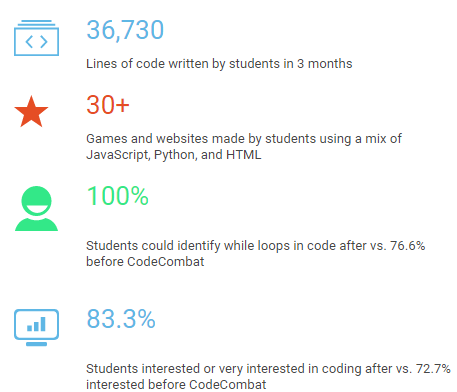
CodeCombat was able to not only provide valuable pilot results for the district but keep students involved in the club and thinking about computer science in a new way.
Everything you need in one platform
Elementary Technology Teacher, Sandy Ahlstrom teaches hundreds of students across 5 different elementary schools in the Sheridan School District. Ms. Ahlstrom wanted to offer her 4th and 5th grade students with a focus on coding a resource that could provide tangible concepts in coding and more than just pictures.
When Ms. Ahlstrom learned about CodeCombat through a student she was surprised to see kids playing a game where they were discovering the code behind the game and typing it themselves.
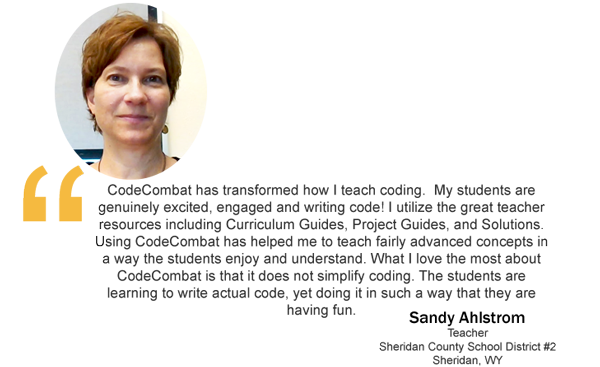
CodeCombat not only teaches students real code but offers a complete computer science platform that Ms. Ahlstrom’s students will be able to take advantage of if they decide to move into more advanced programming principles.
Teachers are provided everything they need to run a full computer science curriculum course and you don’t even need a computer science background:
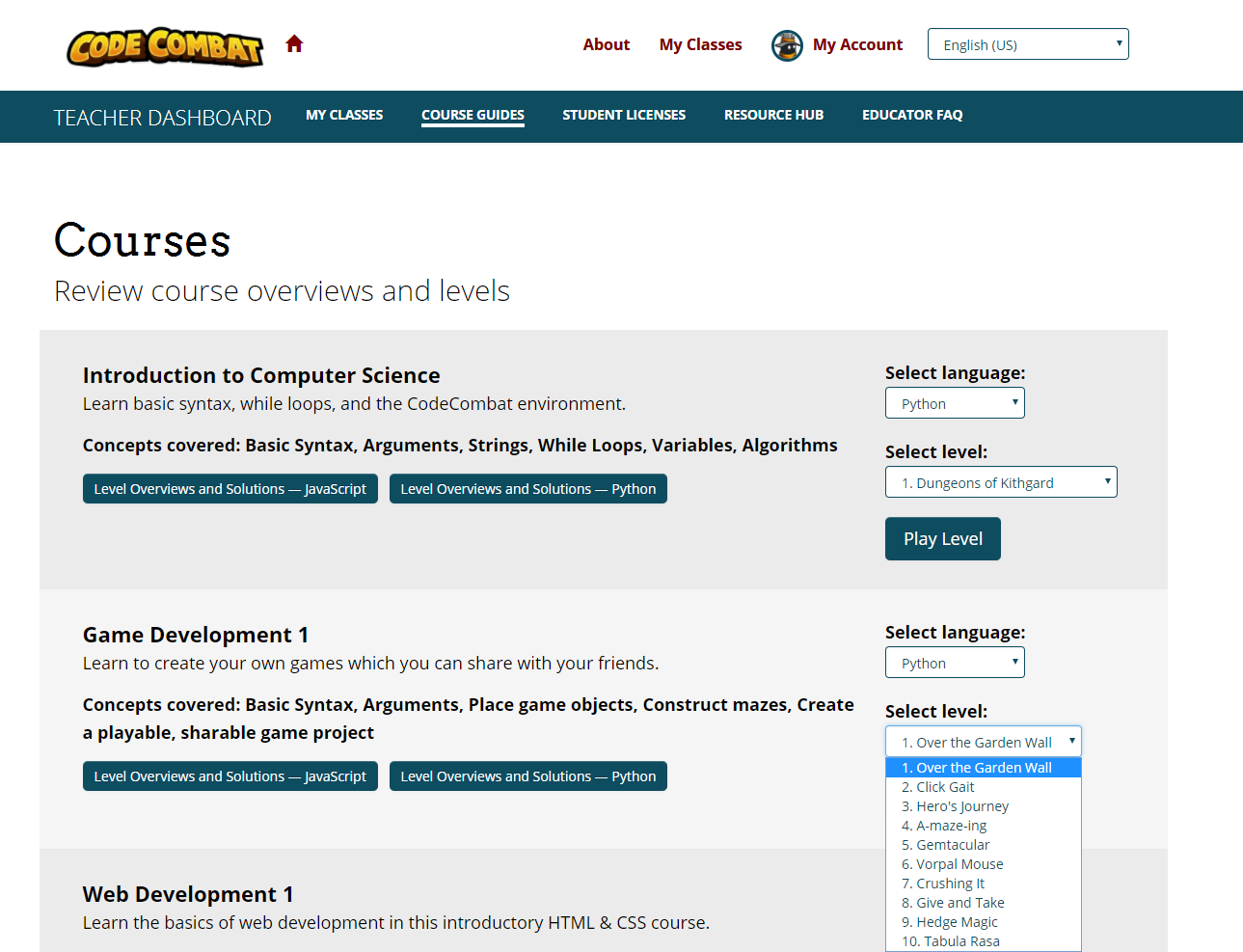
- Your Teacher Dashboard (Create and manage your classes and students, preview and play through any course level, view the lesson plans and solutions for each level, manage and assign student licenses, and much more.
- Your Resource Hub (You'll find pacing guides, the Educator FAQ, printable hints for students, in-class activities, etc)
- Onboarding support (Your own personal guide through CodeCombat if you need any assistance and class support. We’re also an email, phone call, or chat box away)
- Track progress (Follow your student’s progress, completion time and your class statistics.)
When should I consider free options?
If you’re a self-starter who doesn’t need extra support or you don’t mind using more than one resource in your class, free options may seem like a better bet. Options like Code.org are a fantastic way to teach introductory coding concepts. We do recommend you only cover introductory coding concepts for up to a week.
CodeCombat can customize plans for teachers with students ready to learn coding fundamentals and how to apply them with industry language like Python and Javascript. We can work with any district, school, or teacher ready to bring coding into their classroom.
Let us know how we can help at team@codecombat.com.
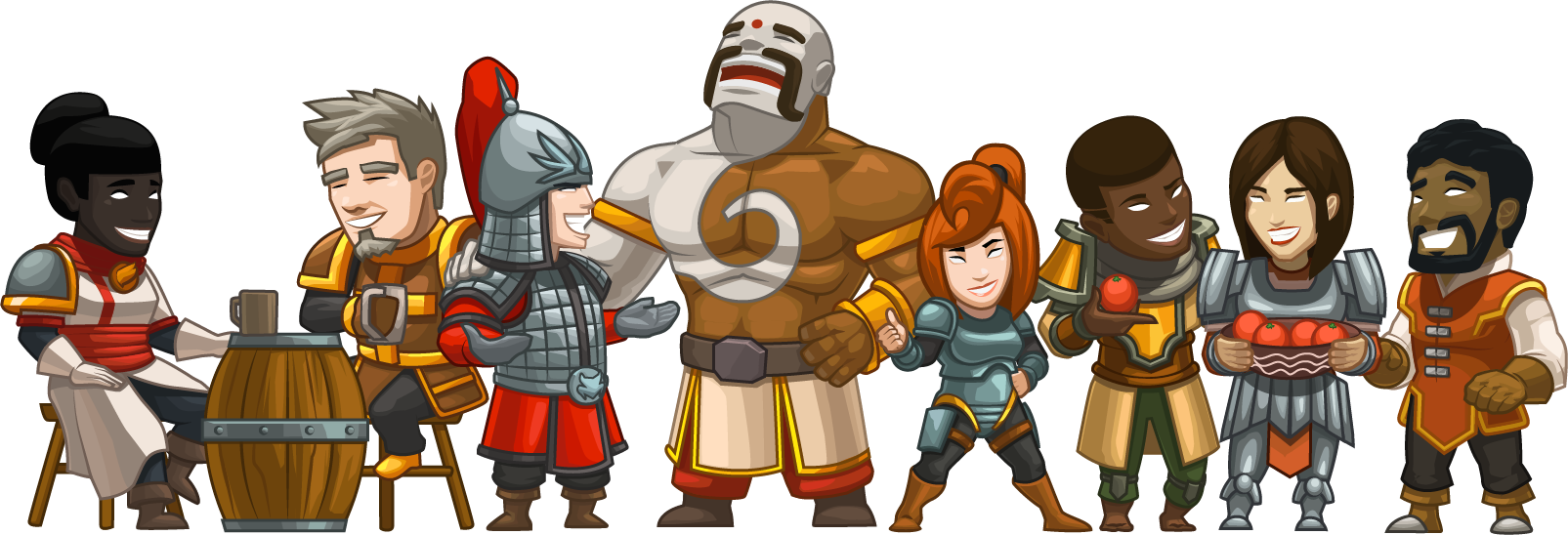
Continue the adventure! Share your pictures, stories and feedback with us on Twitter & Facebook, join the discussion on our Forums or contribute to our open source community. Are you a teacher, CS advocate, parent or administrator? Want to blog for us? Check out this post.

